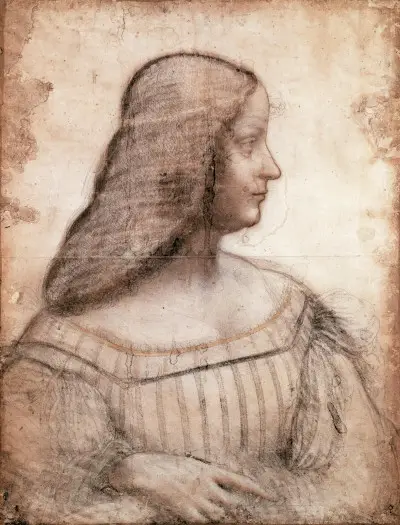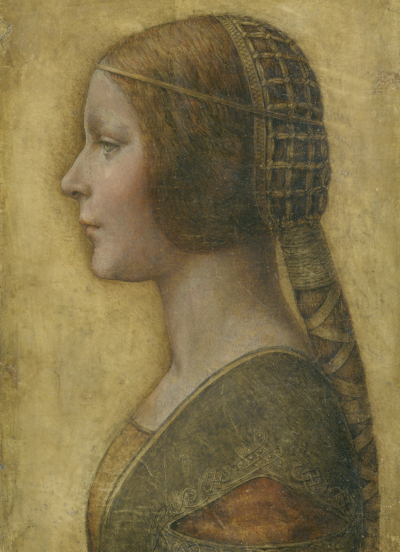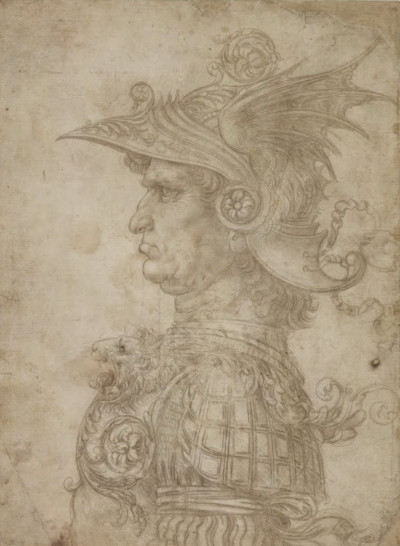Leonardo da Vinci's drawings feature an extraordinary variety in medium, style and content. Here we attempt to examine the different genres in which he worked, and touch on the innovations that he brought to Renaissance Italy.
Introduction
Behind everything that Leonardo da Vinci achieved, laid his foundations as a draughtsman. He would combine his natural genius with extraordinary levels of devotion to this art form, all in the name of achieving the impossible - perfection.
His drawings were diverse in many different ways, with mediums changing over time, and new genres replacing the old as various whims took hold. Whilst he would produce studies for later commissioned paintings, most of his drawings were actually produced purely for fun, and to improve his technical abilities.
As time progressed he would make use of metalpoint, ink and pen plus chalk, and these would suit different challenges, with their own unique advantages. He would also pass on his skills to members of his studio, who would marvel at his work, which was passed around to his students and followers, who would make copies as they went.
Da Vinci's greatest focus would be on the human body, as a strong handling of this was essential for any Renaissance artist. He covered different models, old and young, and would also capture them in full length displays, as well as sometimes focusing on individual limbs to perfect a specific element of his work.
Most of his famous paintings, such as the Mona Lisa, Last Supper and Lady with an Ermine, would have started with a sketched outline, to plan the initial composition. Amending directly on wood panels was not advisible, and so he tried to flesh out his ideas first on paper, before transferring those ideas onto the underpainting.
The different genres discussed below outline how he perfected each and every aspect of his paintings, from the portraits in the foreground, to the touches of detail that surrounded them, to the landscapes which covered everything behind. He left no stone unturned in the pursuit of becoming as good as he could possibly be, and one cannot argue that the levels he eventually achieved were extraordinary.
This article examines the artist's different drawing techniques, his innovations, and also what factors ensured his success. We cover the different genres in which his plethora of sketches sat, and the variety of mediums which he switched between across his career. There is also a list of Leonardo's most famous drawings.
Table of Contents
Leonardo da Vinci's Most Famous Drawings
Genres
Studies for Paintings
The public are often first attracted to his drawings via his more famous paintings, and a good number of his sketches were preparatory pieces for later painted pieces. The mediums that he used in that discipline made it necessary for him to practice his ideas prior to starting the final painting, as amendments could be hard to implement.
If we look at the catalogue of drawings that have survived from his career to the present day, there are some paintings with many drawings remaining, whilst others have none. This may be due to several different reasons, such as simply that many were lost or damaged, but also that perhaps as his career he progressed it became less necessary to practice certain skills which had now become second nature.
The artist chose to keep many of his drawings, as well as his notes on observed thoughts, and on occasion he might re-visit these when planning new works. As such, some study sketches might resemble elements of paintings which followed on many years later, and this would cause art historians some headaches when dating these undocumented items.
Leonardo would very his studies for paintings between quick pen and ink outlines, with an expressive freedom, to fully fledged depictions in metal point or chalk which could be presented as artworks in their own right. He would often tackle a single element of a scene at a time, and then skillfully place these together when switching to a wood panel with tempera or oils.
Head Studies
When producing portraits of heads and profile studies, Leonardo would often combine elements of different faces before, which is a technique that dates back many centuries. He would observe with a great focus, and then dissect the face into his mind as a series of components which could then be re-arranged with other faces for his portraits.
He tended to focus on young men, and the elderly, and enjoyed contrasting the two within his oeuvre. In some cases he would re-use a certain facial structure which had been invented in his mind, and then just tweak the main characteristics for each portrait, choosing a nose and eye style, hair, etc. This allowed him to work quickly and accurately, but on other occasions it would be necessary to depict precisely what he was witnessing, such as for a specifically commissioned portrait.
Portrait of a Man in Red Chalk (Self Portrait) has often been termed a self portrait, but others have claimed it to be a combination of his previous drawings, a merging of different appearances of the elderly that he had observed, with just a few key tweaks to produce an illusion of uniqueness.
Anatomy and Proportion
The human figure was the single most important subject within Renaissance art, and without a strong handling of its challenges, no artist could thrive. Da Vinci therefore spent countless hours studying and practicing his craft, with anatomy and proportion being amongst the most important areas in which to develop his drawing techniques.
Da Vinci realised that he could not only consider the surface of each model, but needed to fully immerse himself in the human body, and all its complex workings, in order to portray his subjects are accurately as possible. Many of the advantages of his research are too subtle for many to notice, but a keen eye will spot the balance of muscles and bones that lie below the surface of his portrait paintings.
As the artist dissected his models into individual muscles and bones, soon he was starting to consider the body as a collection of modules which combined together for each action. This connected well with his engineering designs, in which imaginative inventions would be constructed from the combination of different components.
The artist would then start to use movement within his work, something that had not been seen much before. His understanding of the balance of the body helped in this regard, but he would then need to study the body in movement with the same focus. Perhaps this is where his interest in horses grew too, because of the majestic manner in which they sprint across flat landscapes.
An inevitable extension of his interest in anatomy would be to delve deeper into proportion, attempting to understand the ideal ratio of length, both in facial features but also with limbs. Vitruvian Man would be the most memorable drawings from his interest in this genre, but there would be many more examples with lines attached to calculate lengths of certain physical features.
Figurative Sketches
The artist would practice figurative drawings endlessly, always striving for improvements, even as he entered the final years of his life. Leonardo took on the theme of the Madonna particularly frequently, partly because this theme would appear in his paintings several times over.
Da Vinci also depicted young men in a variety of guises, normally expressing himself with pen and ink, with quick outlines of a number of poses, often placed together on the same page. This development of his figurative techniques could then be carried over into a wide variety of projects, and so always felt like a good use of time for the artist.
Many of these pages have been collated and documented in recent years, allowing us to study his own studies, if you like, and to understand more about the work processes that he used. Many similar outlines would then appear upon wooden panels, as his underpainting, as the artist fleshed out his compositions and planned for the oils or tempera which were to be applied at a later date.
Horses and Equestrian Monuments
Leonardo became highly interested in depicting horses within his work, perhaps more than any other animal. They held a particular significance within the Italian Renaissance but he also understood how differently they were built to humans, and so required a customised approach within art.
He therefore set about studying the in great detail, endless sketching this beautiful animal from a variety of angles. One he had accomplished a level of accuracy with which he was satisfied, it quickly became clear that these skills could also be used to sketch out designs for monuments which featured horses within them.
In order to avoid having to constantly source horses to observe, the artist would eventually start to invent ficticious battle scenes in his own mind, which allowed him to combine his horse drawings with other genres, such as landscapes. He would switch between images of reality and imagination fairly frequently, across different disciplines.
Leonardo was always searching for perfection, and realised that in order to get somewhere near this impossible dream, he would need to devote large amounts of his time to studying and sketching all of the content that he was interested in. Horses were beautiful creatures who also held symbolic value within the Renaissance, and had a connection to the rich and powerful, thus becoming the ideal animal with which to devote a considerable amount of his precious time.
Da Vinci's portraits of other animals would include bears, dragons, dogs and cows. He would pay attention to their heads and paws, often completing a number of studies together on the same sheet - early in his life paper would be fairly expensive, and so many artists would cram studies up against each other in this manner§.
Landscapes and Botany
Leonardo produced a large number of studies of mountainous regions also studied the impact of water events on the environment. Some of that work was to support his engineering projects, though the landscape scenes were quickly intended to be translated into colour for his backgrounds in a number of oil paintings.
The artist would often create scenes from his imagination, and so the term "study" is only used loosely here. His local environment in Italy would have inspired much of what we see within these landscape drawings, but as he moved around Italy several times, new styles of scenery would have come to his attention.
Within his paintings he would often use scenery in a manner which led our eyes from the main focal point in the foreground, all the way to the back of the painting, with perhaps a winding river leading us along this path. He tended to cover rocky landscapes, with extreme contrasts between the foreground and background levels.
The artist also produced a number of botany studies, partly for personal interest, but also because these plants and flowers could be incorporated into his paintings to add some aesthetic value. Da Vinci was a passionate lover of both humanity but also the natural world, and constantly revelled in its beauty, whilst also wanting to learn more about how it all worked.
Techniques
Repetition and Practice
Whilst Leonardo is rightly regarded as a genius, his talents as a draughtsman were honed over decades, and from the result of careful observation and endless practice. He left behind 13,000 pages of drawings and notes which underline how he tried to understand what he was looking at. He went to great lengths to produce the most accurate drawings, delving below the surface to see how things were constructed.
Exaggeration and Contrast
The artist's portraits were often of young men in their prime, or the elderly very much beyond their own. He loved the contrast, and once wrote that he liked to place varying aged models together, and after careful observation he would start to see only their similarities. His series of grotesque cartoons offer him at his most extreme, and it was here that his understand of anatomy would be combined with imagination and a sense of fun.
Mediums
Leonardo made use of metalpoint and pen and ink for his earliest drawings, and truly mastered both techniques over a period of several decades. He would later switch to chalk, and produce some of his best work using that medium. In his final years he would try out many different combinations and sought to make use of the skills that he had honed over the previous decades.
Metalpoint
Metalpoint typically involves the application of silver onto an abrasive surface, and Da Vinci used this method when sketching items in real life. This was the main method for most Renaissance artists at the time, but Da Vinci would witness its decline, with many artists moving on to chalk by the start of the 16th century.
Metalpoint is an unforgiving medium which helped force Leonardo to master a precise manner of drawing, where mistakes could not simply be corrected as one might have liked. This helped provide him with an excellent grounding as a draftsman, with skills that could then be carried over into other disciplines.
Pen and Ink
Leonardo found pen and ink offered him an alternative to metalpoint which was better suited to more expressive drawings. When working away from reality, but instead building images from his own imagination, he would often use the more relaxed medium of pen and ink. After a period using chalks, this option would return again in the last decade of his lifetime.
Chalk
Chalks arrived relatively late in Da Vinci's career as a draughtsman. He would have been in his early forties by the time that he first started to use this medium for his drawings. Eventually he grew to love this medium and would use it instead of metalpoint from there on. He would use paper that was tinted in the same colour as his chalk, limiting the variation and forcing a more precise, subtle finish.
Towards the end of his career, Leonardo would tend to choose black chalk over red, and also to experiment a little more with the different combinations of mediums that he used. Perhaps he was aware that time was running down, and he wanted to be as creative as he possibly could be.
Paper
Whilst Leonardo tried out many different mediums for his drawings, that were all applied to paper. Typically he would make use of white paper, sometimes blue, but he also experimented with slight tints when using chalk. During the artist's own lifetime he would witness the arrival of paper as an everyday, affordable commodity for the first time, and so artists became more able to practice their craft without having to cram multiple sketches on the same page.
The nature of paper meant many drawings would be damaged whilst be passed around his studio, or gifted to others. However, a sufficient number have survived to the present day that historians can survey a huge breadth of his work within this discipline. All of the major genres in which he worked such as anatomical studies, grotesque portraits and nature studies are all represented with items that have survived to the present day.
References
- Leonardo. The Complete Paintings and Drawings, Frank Zöllner & Johannes Nathan, Taschen
- Leonardo da Vinci, Walter Isaacson



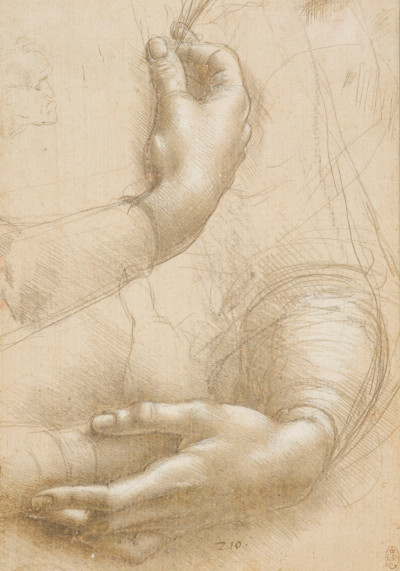
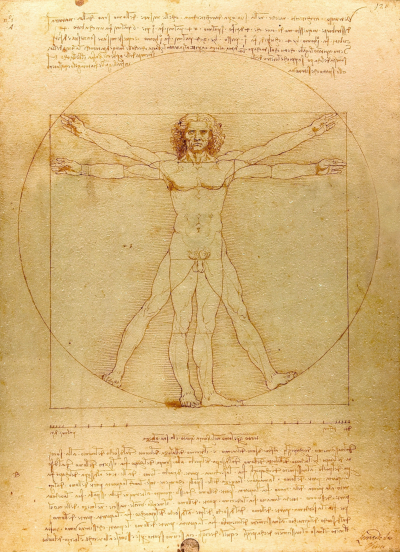
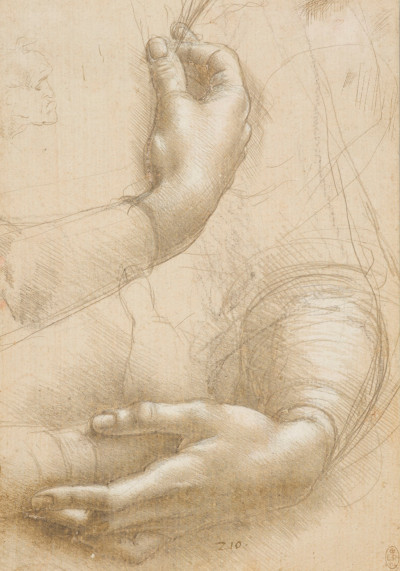
 Leonardo da Vinci.jpg)
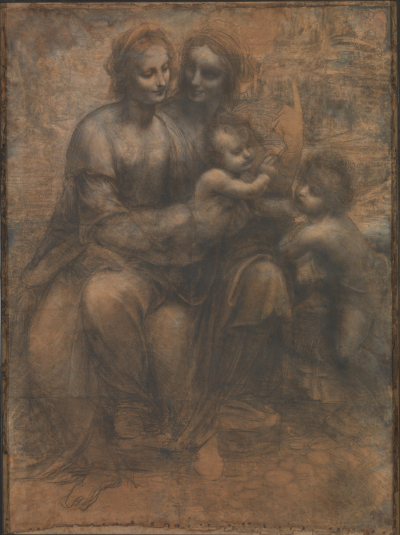
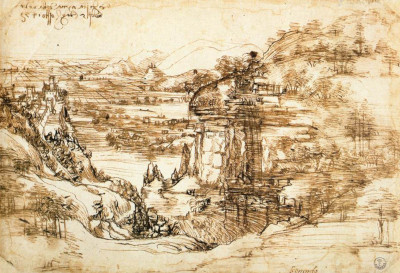
 Leonardo da Vinci.jpg)
